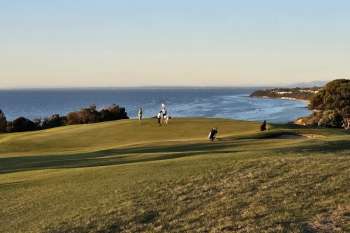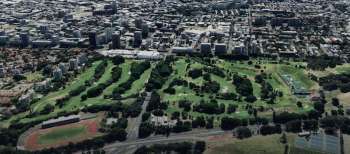This June the 2010 US Open returns to the Pebble Beach Resort in California, one of the most famous, and certainly the most beautiful, patches of turf in world golf. As we watch this year’s championship and marvel at the scenery, it’s worth asking the question – is Pebble Beach as good as it looks on television, and how does it compare to its revered neighbour Cypress Point?
Despite their proximity and glamorous Monterey Peninsula settings, Pebble Beach and Cypress Point are actually quite different. For a start, one is a public facility while the other is about as exclusive and private as golf clubs get. More importantly, however, the topography and design philosophies are also poles apart. Much of Pebble Beach is set along a sheltered cove at the southern end of the Peninsula, the site more protected from the Pacific and, as a result, with fewer wild dunes and natural fairway undulations. Cypress, by contrast, was built on the Monterey’s western tip and is totally exposed to the elements. It has three incredible ocean holes, but most of the course is carved through large, unkempt sand dunes away from the sea.
It’s important to remember at this point, that Pebble Beach was initially created by a couple of amateur golfers, while Cypress Point was designed by arguably the most accomplished course architect our game has ever known, Dr Alister MacKenzie. Not surprisingly, Cypress Point has barely changed since its 1928 opening and still retains all the classic elements of Golden Age architecture; width, angled greens, naturalistic bunkering and strategic risk/reward design. By contrast, the current Pebble Beach layout is a tough, long, penal tournament slog; its fairways are narrow, its greens are small and circular and the rough here is lush and dangerous. Pebble also has a more formal, manicured appearance than Cypress Point, although in its earliest guise the layout was actually quite rugged. The older greens were also larger and often surrounded by sandy wastelands.
In terms of structural changes, the most significant at Pebble Beach were made shortly after it opened in 1919. The original designers, Jack Neville and Douglas Grant, hadn’t built courses before but they knew enough about the game to recognise the need to route as much golf as possible along the curving coastline. Their layout was far from perfect, however, and it was continually tweaked in the 1920s, first by Herbert Fowler who created Pebble’s iconic finishing hole, and then by H. Chandler Egan, who reshaped almost all of the greens and bunkers prior to the 1929 US Amateur. Crucially, he also shifted the 9th fairway out toward the ocean, and angled the green to favour those hitting nearer the water. Jack Nicklaus later built the par three 5th on land that had initially been off-limits because of an existing property.
What’s interesting about both these wonderful courses is that they were developed by a non-golfer named Samuel Morse, who was introduced to the region in 1915 while acting as liquidator for a company that owned most of the land here. Morse felt that a golf course would make the area more attractive to prospective buyers, and convinced the company to invest in the building of Pebble Beach. He selected amateur designers principally to keep the costs down. In a unique twist, by the time the course was finished Morse had fallen for the area and purchased it himself, as part of an 18,000-acre property that incorporated Monterey’s vast Del Monte forest as well as further coastal land that would later house more golf, including the Cypress Point Club.
Cypress was actually conceived by champion golfer Marion Hollins, who worked for Morse and suggested the establishment of a private club within his subdivision, as an alternative to the more accessible golf available on the Peninsula. Hollins originally hired one of America’s best-credentialed architects, Seth Raynor, as course designer. When Raynor died suddenly in 1925, she appointed Dr Alister MacKenzie as his replacement. There would be no amateur architects here.
The MacKenzie appointment seems an obvious one in hindsight, but at the time he hadn’t yet designed Augusta National, Crystal Downs or Pasatiempo, nor was his work in Australia finished and internationally regarded. Indeed, the appointment was likely based on reputation and aided, no doubt, by MacKenzie’s voracious appetite for self-promotion. There is evidence to suggest that Morse was initially unconvinced by the Englishman, and had him reshape a couple of green sites at Pebble to show that he was capable of handling the assignment. The great designer often wrote of the need for ‘finality of design’ and for developers to employ qualified and capable course architects to prevent the continual, and expensive, reworking of their holes. Morse had first-hand experience here, and had seemingly formed a view that, on this occasion, it was worth paying for professional design services. Few who have seen Cypress Point would argue his money wasn’t well spent.
It is interesting to consider how Pebble Beach might have looked designed by a professional architect. It’s unlikely that the present coastal routing could be improved upon, but I suspect some of the interior holes might have been arranged differently and there certainly would have been a greater emphasis on strategic, rather than accurate, play. Regardless, in the context of great golf and the history of Golden Age architecture in America, it is impossible to overstate the importance of both Monterey masterpieces.
Cypress Point, for example, hosted legendary amateur golfer Bobby Jones in the summer of 1929, after Jones had suffered a shock first-round loss in the US Amateur at Pebble Beach. With time on his hands, Jones played several rounds at Cypress and then headed north to Santa Cruz for the opening of MacKenzie’s beloved Pasatiempo golf course. It was here that Jones and MacKenzie first exchanged views on design, and where Jones decided that it was MacKenzie who should help him create the Augusta National golf course. That decision was clearly an astute one, last year Golf Digest ranked Augusta National the number 1 course in America, Cypress Point was 4th. This same magazine created a sensation back in 2001 when it had Pebble Beach in top spot, largely on the back of the extraordinary US Open of 2000. The course has slowly dropped ever since and is currently ranked 6th, which, in my view, is, still a touch generous.
It’s not that Pebble Beach isn’t an outstanding golf course, but when you get into the upper echelon of world golf there are clear degrees of greatness, and in some key areas the course falls a little short. Most people assume it’s the inland holes that hold Pebble back, and while true there are also some problems with the coastal golf as well. The par five 6th, for example, is a fine three-shot test for the world’s best professionals, but the hill leading to the green is too steep for regular golfers to clear on their second shot, meaning most will plug into the face and have to play a funky hillbilly third from a vertical uphill stance. Also technology has hurt the 8th hole somewhat, because although the approach is still the most breathtaking shot on the course, the drive has become far less exciting now that you only need to hit a hybrid or long iron to stay clear of the cliff. The other surprise here is hole 17, a deadly par three with a wonderful backdrop but a target area that is angled so acutely across the tee, and so shallow, that it’s almost unplayable for the average guest.
On the positive side, there is no denying that Pebble Beach is the most beautiful place for golf in America, nor that the 7th, 8th, 9th, 10th and 18th holes are among the greatest in the country. Cypress Point is not short on glamour holes either, and although it lacks a strong par five and is a little short for the modern professional, there is more variety here and the best golf is absolutely astonishing. The one-shotters are brilliant, and diverse, while the reachable fives and strategic fours are all original and charismatic, particularly back-and-forth short par fours at the 8th and 9th and wondrous longer tests like the 11th, 12th, 13th and 17th.
Samuel Morse left an incredible golfing legacy when he passed in 1969, for not only is his treasured Pebble Beach Resort celebrated across the globe, but by employing MacKenzie to design Cypress Point he ensured that every subsequent golf architect would have a benchmark for future work. These are clearly two of the greatest courses in the world, and how highly you rank them depends largely on your personal preferences and views on whether golf needs to be difficult to be outstanding.
As for this month’s US Open, viewers can expect a typically bruising affair as the USGA will probably set Pebble Beach up to offer no respite for inaccurate play and will remove approach shot subtleties by ensuring the greens are rock hard and surrounded by choking roughs. It will still look great on television, and no doubt entice thousands watching to make the trek to Monterey for their dream round. If only Cypress Point wasn’t so private, it would be possible to experience both spectacular and stupendous golf within a one-mile radius.
Darius Oliver, Architecture Editor Australian Golf Digest




